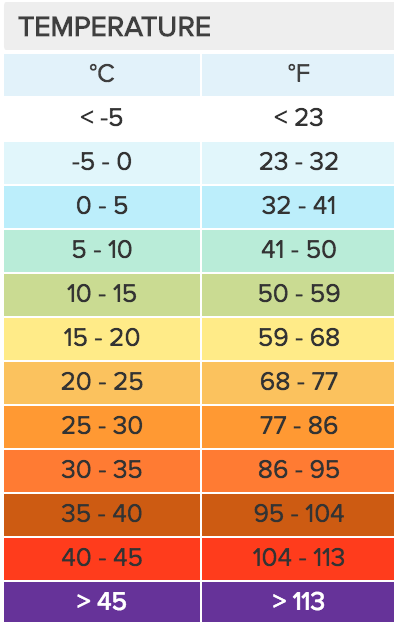Forecast
Broke (34.9857°S, 116.629°E, 8m AMSL) set as my default location ›
-
My MLA
-
Current condition
TOMORROW13° 20° mostly cloudy Chance of rain: 10% Likely amount: < 1mm First
light

Last light Sunrise Sunset 6:22am WST 6:48am WST 5:40pm WST 6:06pm WST NOW14.4° Feels Like: 10.9° Relative Humidity: 75% Dew: 10.0° Wind: NE 19km/h Gust: 26km/h Rainfall since 9am: 0.0mm Pressure: 1030.8hPa -
Today Weather
BrokeNow11.5°cFeels Like:9.8°Wind:SE 7km/hGusts:7km/hHumidity:83%13°Min20°MaxToday in BrokePartly cloudy. Winds E 20 to 30 km/h becoming light in the evening. Overnight temperatures falling to between 7 and 11 with daytime temperatures reaching the low to mid 20s.Tomorrow13°Min20°MaxMostly sunny. Light winds becoming NE 15 to 20 km/h in the morning then becoming light in the middle of the day. Overnight temperatures falling to between 8 and 11 with daytime temperatures reaching the mid 20s. -
Radar
-
Popup Radar
-
Warnings
There are no current warnings for Broke
-
7 day forecast
Today: Partly cloudy. Winds E 20 to 30 km/h becoming light in the evening. Overnight temperatures falling to between 7 and 11 with daytime temperatures reaching the low to mid 20s.
Forecast for Broke (34.9857°S, 116.629°E, 8m AMSL) Thu Fri Sat Sun Mon Tue Wed Summary Minimum 13° 13° 14° 15° 14° 17° 18° Maximum 20° 21° 20° 18° 21° 21° 23° Chance of rain 10% 5% 30% 40% 50% 30% 50% Likely amount < 1mm < 1mm < 1mm 1-5mm 1-5mm < 1mm < 1mm UV index Moderate Moderate Moderate Moderate Moderate Moderate Moderate Fire Danger Rating High Moderate Moderate Moderate - - - Frost risk Nil Nil Nil Nil Nil Nil Nil 9am 3pm 9am 3pm 9am 3pm 9am 3pm 9am 3pm 9am 3pm 9am 3pm Wind speed 20
(km/h)20
(km/h)18
(km/h)13
(km/h)11
(km/h)16
(km/h)14
(km/h)28
(km/h)27
(km/h)29
(km/h)28
(km/h)21
(km/h)16
(km/h)12
(km/h)Wind direction ENE E NE SSW WNW WSW SE SE E ESE E ENE NE E Relative humidity 70% 45% 66% 54% 72% 60% 83% 74% 77% 61% 75% 61% 74% 61% Dew point 10°C 8°C 10°C 11°C 12°C 12°C 13°C 13°C 12°C 13°C 13°C 13°C 14°C 15°C -
28 Day Rainfall forecast
-
12 Month Rainfall Forecast
Broke Rain Forecast
Broke 12-month Rainfall ForecastAprMayJunJulAugSepOctNovDecJanFebMar202420252565565108766105012 - 34 - 78 - 910Well below normalBelow normalNear normalAbove normalWell above normalIssue Notes - Issued Apr 23
ENSO status: Inactive/Neutral. El Niño ended. IOD status: Neutral, becoming strongly positive. SAM status: Leading to neutral and returning positive. The El Niño Southern Oscillation (ENSO) is presently in an inactive phase, for the first time since August 2021. Ocean cooling continues over the eastern Pacific Ocean as sea surface temperatures approach near-normal conditions. Warmer than normal waters are present across the western Pacific Ocean, including the Coral Sea with added moisture and humidity to influence weather conditions in the eastern regions of Australia. The atmosphere continues to be firmly neutral after weakening early in the year with 3 out of 7 global models forecasting a La Niña to develop this coming winter season. A neutral ENSO typically has no significant impact on Australian rainfall during winter. The Indian Ocean Dipole (IOD) is in a neutral phase, although record-high ocean temperatures across the northwest Indian Ocean have the IOD index just tipping into a positivethreshold value. Persistent southeasterly winds over the eastern Indian Ocean during the previous month are forecast to ease with below-average wind speeds to develop off northwest Australia and the eastern Indian Ocean during the winter season. All international models are suggesting the IOD will strengthen into a strong positive phase over the next 2-3 months, with significant upwelling to start near Indonesia possibly following May. A positive IOD reduces the number of northwest cloudbands that cross Australia during winter and spring, thus reducing rainfall across central and southeastern parts of Australia. The Southern Annular Mode (SAM) is currently positive (mid-April) with the outlook favouring a neutral phase forecast in May and then the likelihood of returning to a positive phase during winter. A positive SAM increases easterly winds, increasing rainfall and thunderstorm activity in the east. A positive SAM also reduces the impact of cold fronts and decreases the rainfall over southernAustralia. Rainfall outlooks are showing above-average rainfall over winter for WA and central and northern SA, and eastern regions of QLD and NSW. Conversely, below-average rainfall is expected for western TAS, southern SA, and most of VIC.
-
Popup - Daily historical
-
Long range rainfall forecast
-
Past 5 Days
Broke Past 5 Days
This MonthMinimum Maximum Rainfall Saturday
Apr 2016.1 °C 30.0 °C 0.0 mmSunday
Apr 2112.4 °C 29.4 °C 0.0 mmMonday
Apr 2213.5 °C 18.5 °C 3.8 mmTuesday
Apr 2313.4 °C 17.3 °C 0.0 mmWednesday
Apr 2410.3 °C 19.3 °C 0.0 mmLegend -
Almanac
Almanac
Broke minimum temp history (34.9857°S, 116.629°E, 8m AMSL) MAXIMUM TEMPERATURE MINIMUM TEMPERATURE Hottest this month 30.1° 19/04/2024 Coldest this month 10.1° 14/04/2024 Hottest on record 34.0 05/04/2011 Coldest on record 6.5 20/04/2006 Hottest this year 39.9° 20/02/2024 Coldest this year 8.6° 10/03/2024 Long term average 21.4° Long term average 12.8° Average this month 23.6° Average this month 13.0° Hottest April On Record Avg. max. temp. 23.7° 2011 Coldest April on record Avg. min. temp. 11.5° 2005 Broke rainfall history (34.9857°S, 116.629°E, 8m AMSL) RAINFALL Wettest This Month 3.8mm 22/04/2024 Total This Month 4.0mm
2.0 daysLong Term Average 90.2mm 15.5 days Wettest April on record 208.4mm 2005 Driest on record 9.2mm 2009 -
Year to Date
Broke Year To Date
Average Rainfall To Apr 178.0mm 44.2 day(s) Total For 2024 36.0mm 24.0 day(s) Total To This Day 2023 162.8mm 45.0 day(s) Wettest Day 6.0mm Jan 2 Lowest Temperature 8.6°C Mar10 Highest Temperature 39.9°C Feb20 -
Popup - Radar
Weather Radar for Australia
Australia Radars
- Adelaide
- Adelaide Airport
- Adelaide Sellicks
- Albany
- Alice Springs
- Bairnsdale
- Bowen
- Brewarrina
- Brisbane
- Brisbane Airport
- Brisbane Marburg
- Broadmeadows
- Broome
- Cairns
- Cairns Airport
- Canberra
- Carnarvon
- Ceduna
- Coffs Harbour
- Dampier
- Darwin
- Darwin Airport
- Emerald
- Esperance
- Eucla
- Geraldton
- Giles
- Gladstone
-
Popup - Monthly historical
-
Climatology
Climate History
Broke Climatology
Broke Long-Term Averages
Long-Term Averages Jan Feb Mar Apr May Jun Jul Aug Sep Oct Nov Dec Ann Mean Max (°C) 24.5 24.9 23.9 21.4 19.1 17.0 16.1 16.6 17.6 19.0 20.8 22.7 20.3 Mean Min (°C) 14.4 15.1 14.6 12.8 11.2 9.9 9.0 9.0 9.3 10.4 11.6 12.9 11.7 Mean Rain (mm) 26.1 22.7 39.0 90.2 117.1 160.5 181.9 164.4 112.4 75.5 56.4 37.4 1066.6 Mean Rain Days 8.6 8.2 11.9 15.5 18.4 19.8 22.4 22.5 18.9 16.4 13.6 11.2 182.3



